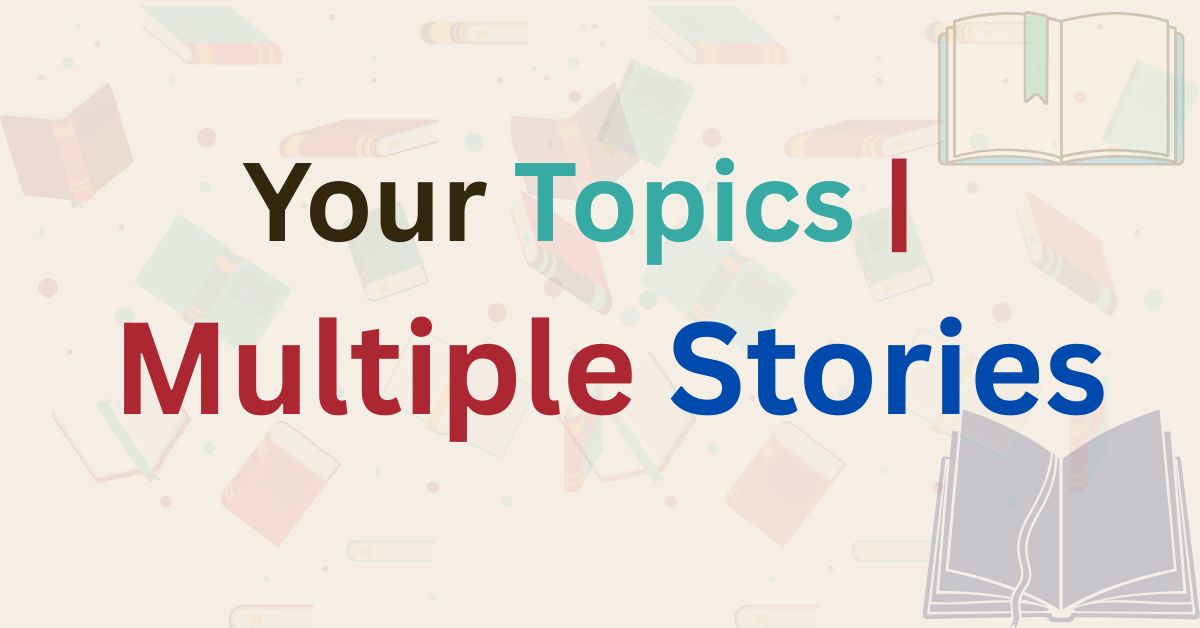Every writer faces the dreaded blank page, but what if one simple concept could spawn dozens of compelling stories? The secret lies in understanding your topics multiple stories meaning—the ability to extract endless narratives from a single theme.
This comprehensive guide reveals over 100 creative approaches to multiply your storytelling potential exponentially.
25+ Story Concepts That Captivate

Contemporary Drama Catalysts
Your topics multiple stories examples flourish in everyday settings. Consider a simple coffee shop: you could explore the barista’s immigration journey, the regular customer’s divorce proceedings, or the landlord’s gentrification dilemma. Each angle creates distinct emotional landscapes while maintaining thematic coherence.
Workplace dynamics provide particularly rich material. A hospital emergency room generates stories about medical ethics, personal sacrifice, systemic healthcare failures, and human resilience. The key lies in identifying the multiple perspectives inherent in any professional environment.
Speculative Fiction Springboards
Narrative creativity explodes when you blend familiar concepts with speculative elements. Take social media addiction—transform it into a dystopian tale where likes become currency, or explore a near-future world where digital detox retreats become mandatory government programs.
Plot development accelerates when you ask “what if” questions repeatedly. What if memory storage became external? What if climate change reversed overnight? Each speculation births multiple story variations exploring different character types, time periods, and societal implications.
Non-Fiction Narratives: 20+ Compelling Real-World Angles
Personal Essay Provocations
Storytelling angles in personal narratives multiply through temporal shifts. Your childhood fear of swimming becomes three stories: the eight-year-old’s terror, the teenager’s shame, and the adult’s therapeutic breakthrough. Each timeline offers unique insights while maintaining narrative coherence.
Creative writing prompts often overlook the power of ordinary experiences. A family dinner contains stories about cultural assimilation, generational conflict, economic stress, and hidden family secrets. The magic lies in choosing which lens to focus through.
Investigative Feature Concepts
Story starters for non-fiction emerge from local newspapers and community bulletin boards. That closed factory downtown? It’s simultaneously a story about economic policy, environmental contamination, worker displacement, and urban decay. Multiple plot lines naturally emerge when you interview different stakeholders.
Digital content creation thrives on these multi-angle approaches. Your investigation into local housing costs becomes content for policy blogs, human interest features, economic analysis pieces, and social media campaigns—each serving different audiences while sharing core research.
Digital Age Storytelling: 15+ Modern Format Ideas
Social Media Serialization
Interactive presentations don’t just inform—they engage audiences through narrative diversity. Instagram story arcs work particularly well for transformation narratives, allowing followers to witness character development in real-time. TikTok’s format demands plot twists every 15 seconds, forcing writers to distill dramatic tension into micro-moments.
AI-powered presentation creator tools like MagicSlides app revolutionize how stories reach audiences. Writers can now transform your ideas into slides that combine visual storytelling with traditional narrative structure. This presentation software enables endless storytelling possibilities across platforms.
Interactive and Multimedia Stories
Engaging slides have evolved beyond bullet points. Modern digital storytelling incorporates choose-your-own-adventure elements, podcast series, and multimedia decks that respond to reader choices. AI-enhanced design tools create visually appealing slides that support rather than distract from narrative content.
Smart presentation maker technology allows writers to create dynamic presentations where stories unfold based on audience interaction. The MagicSlides platform exemplifies how automated presentation tool capabilities can enhance rather than replace human creativity.
20+ Inclusive Perspectives
Underrepresented Voices Amplification
Thematic stories gain power through authentic representation. Instead of writing about communities you don’t understand, focus on universal themes experienced differently across cultures. Love, loss, ambition, and fear manifest uniquely in different cultural contexts, providing endless stories from one topic.
Narrative prompts should challenge assumptions about whose stories matter. The immigrant experience isn’t monolithic—it varies dramatically based on country of origin, economic status, education level, and receiving community characteristics. Each variable creates distinct storytelling diversity.
Regional and Local Storytelling
Story topics with multiple angles often hide in plain sight within local communities. Your neighborhood’s gentrification contains stories about longtime residents, new arrivals, business owners, city planners, and real estate developers. Each perspective illuminates different aspects of urban change.
Content development benefits from hyperlocal focus. Stories about your specific community resonate more powerfully than generic urban tales. Readers connect with familiar landmarks, local politics, and regional challenges that reflect broader societal issues.
25+ Targeted Concepts
Mystery and Thriller Blueprints
Fiction writing in mystery genres multiplies through perspective shifts. The same murder investigation becomes different stories when told through the detective’s eyes, the suspect’s experience, the victim’s family, or the forensic scientist’s methodology. Each viewpoint reveals different clues and emotional stakes.
Plot twists multiply when you understand that every mystery contains at least five stories: the crime itself, the investigation, the perpetrator’s motivation, the impact on the community, and the resolution’s consequences. Professional mystery writers like Tana French excel at weaving these multiple outcomes together.
Science Fiction and Fantasy Frameworks
Creative variations flourish in speculative genres because world-building creates infinite story possibilities. A single magical system generates stories about discovery, mastery, abuse, regulation, and revolution. Each exploration maintains thematic consistency while offering fresh narrative territory.
Storytelling craft in fantasy particularly benefits from cultural mythology research. Every culture’s folklore contains story structures that can be adapted, combined, and modernized. This approach ensures varied narratives that feel both familiar and surprising.
Systematic Idea Generation
The SCAMPER Method for Narrative Development
Fictional scenarios multiply through systematic creativity techniques. SCAMPER (Substitute, Combine, Adapt, Modify, Put to other use, Eliminate, Reverse) transforms basic premises into endless storylines. Take a simple concept like “first day at a new job“—substitute the workplace with a space station, combine it with a romantic subplot, or reverse it to focus on the last day instead.
Inspiration prompts become more powerful when you understand they’re starting points, not destinations. Professional screenwriters often begin with generic prompts but develop them through systematic questioning. What’s the character’s biggest fear? What happens if they succeed? What if they fail spectacularly?
Character-Driven Ideation Techniques
Creative authoring succeeds when characters drive story multiplication. A single protagonist archetype—the reluctant hero—generates dozens of stories depending on the specific reluctance source. Fear of failure, fear of success, moral objections, physical limitations, or family obligations each create distinct narrative paths.
Story visualization helps writers see how character combinations create natural conflicts. The methodical scientist paired with the impulsive artist, the optimistic immigrant working for the cynical native-born boss, or the tech-savvy teenager teaching the traditional grandparent—each pairing contains multiple story seeds.
Cross-Platform Story Adaptation Strategies
Single Concept, Multiple Formats
Screenwriting and content creation share adaptation principles. A single story concept adapts differently for different platforms: the blog post version emphasizes internal reflection, the podcast episode focuses on dialogue and sound design, while the video essay combines visual elements with narrative structure. Each format reveals different story aspects.
AI-assisted presentations streamline this adaptation process. Tools like stunning presentation using AI technology help writers visualize how stories translate across mediums. Automated slide creation allows rapid prototyping of story concepts for different audiences and platforms.
Audience-Specific Modifications
Business slideshows require different narrative approaches than entertainment content. The same climate change story becomes a policy presentation for government officials, an educational slideshow for students, or an investment pitch for venture capitalists. AI-enhanced decks help maintain story coherence while adapting tone and complexity.
Smart presentations recognize that audience determines story emphasis. Technical audiences want process details, emotional audiences connect with personal impacts, and decision-makers need clear action steps. Concept presentations succeed when they match story elements to audience priorities.
Overcoming Creative Bottlenecks: Practical Implementation
Daily Practice Frameworks
Interactive slideshows work excellently for story brainstorming sessions. Create presentations where each slide poses a story question: “What if gravity stopped working?” “What would happen if everyone could read minds?” “How would society change if lying became impossible?” Beautiful decks make brainstorming more engaging and productive.
Idea visualization through structured exercises prevents creative blocks. Set aside fifteen minutes daily to explore multiple narratives from newspaper headlines, overheard conversations, or random Wikipedia articles. Document everything—quantity matters more than immediate quality.
Research and Inspiration Cultivation
Digital storytelling thrives on systematic research habits. Create content calendars that rotate between different story source types: historical archives one day, scientific journals the next, social media trends the third. This variety ensures storytelling diversity while preventing creative stagnation.
Concept slides help organize research findings into story possibilities. Create slide decks where each research discovery gets its own slide with potential story angles listed below. Idea-to-slide conversion makes abstract concepts more concrete and actionable.
Technology Tools for Story Organization
Digital Workflow Systems
Smart slide creator tools revolutionize story organization. Instead of traditional outlines, create visual story maps where each potential narrative gets its own slide with character notes, plot points, and thematic elements. Presentation design tool capabilities make complex story relationships more visible and manageable.
Deck creator software helps writers maintain story coherence across multiple projects. Color-code slides by genre, audience, or development stage. Slide generator features automate formatting so writers focus on creative development rather than technical presentation details.
Collaboration Platforms
Multimedia decks facilitate collaborative storytelling. Writers, editors, and illustrators can contribute to shared presentations where stories evolve through collective input. Interactive presentations allow real-time feedback and suggestion integration.
Automated presentation tool capabilities streamline collaboration workflows. Team members can contribute story elements asynchronously while AI-based slides maintain visual consistency. This approach particularly benefits content development teams working on multiple projects simultaneously.










